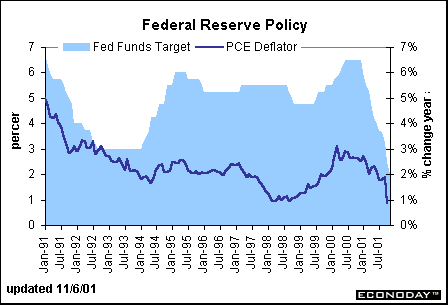Tuesday's Fed action
The FOMC announced a 50 basis point rate cut at the end of their meeting on Tuesday, bringing the federal funds rate target
down to 2 percent and the discount rate down to 1.5 percent. In the past year, the Fed has reduced the federal funds rate target
by 450 basis points to its lowest level since August and September of 1961. Along with the rate cut, the Fed issued a statement
noting that they would maintain their bias towards easing since the risks were weighted towards weaker economic activity.

Most of us aren't used to seeing the federal funds rate target at such a low level. That's because we have become accustomed
to relatively high inflation rates. It is true that inflation rates have come down in the past ten years - and that has helped bring
down interest rates across the board. Whether the Fed is performing its job of providing liquidity and easing credit conditions
really depends on the real, inflation-adjusted, federal funds rate target, not the nominal level. Thus, we really can't determine to
what degree the Fed is being accommodative until we look at the inflation rate.
Alan Greenspan and other Fed officials prefer the PCE (personal consumption expenditure) deflator to the consumer price index
because it is a better measure of changes in the cost-of-living. The PCE deflator was up 0.9 percent in September 2001 over
the same period a year ago, the last month for which we have data. The sharp drop in the September deflator was due to
insurance premiums affected by the September 11 attacks and might overestimate the improvement in inflation. Nevertheless,
one can say that the inflation rate is closer to 1 percent than it is to 2 percent - the current federal funds rate target.
Typically, one would subtract the inflation rate from the nominal funds rate target in order to get the real fed funds rate. In this
case, using the current fed funds rate less the September PCE deflator gives us a real rate of 1.1 percent. While this is an
accommodative policy, it isn't exceptional. In fact, if you look at the chart above, you'll note that the PCE deflator was equal to the
nominal fed funds rate target back in 1992 for a short while. That produced a 0 percent real funds rate. That was truly
accommodative policy.
Some economists argue that the Fed has not gone far enough to stimulate monetary policy. They point to this fact - that the funds
rate target is not equal to zero yet. In order to provide greater stimulus, the Fed may need to continue these aggressive moves
(50 basis point cuts) in order to align the federal funds rate with the inflation rate. This would get us closer to a zero fed funds rate
in real terms. Most economists expect that the Fed will bring the fed funds rate target down to 1.5 percent by the first quarter of
2002. In fact, most had predicted that the Fed would not change rates at their December meeting a month from now. That
remains to be seen - and will very much depend on current conditions.
The bottom line
The drop in the federal funds rate was expected by equity and bond investors and was generally considered friendly news for the
financial markets. Whether this is friendly news for consumers is another story. Consumers who took advantage of zero percent
financing offered by auto companies clearly are benefiting by the low interest rate environment. Mortgage rates have come
down, although not as much as expected given the 450 basis point drop in the funds rate to date. Credit card companies who
base their interest charges on the prime rate are offering slightly lower rates for consumers, but this is not true for the majority of
credit cards in the hands of consumers. Retail charge cards still offer very high interest rates on their own company cards. If
retailers want to see the kind of improvement in sales recorded by the auto companies in October, they may need to follow the
example set by automakers recently.
Otherwise, the Fed's actions may not quite be in vain, but may take a longer period of time to work through the economy.
Evelina M. Tainer, Chief Economist, Econoday
| 